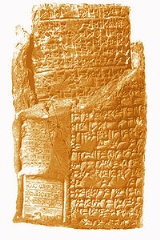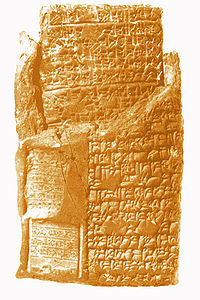
History of writing ancient numbers
Encyclopedia
Pre-history
The first method of counting was counting on fingers. This evolved into sign language for the hand-to-eye communication of numbers. But this was not writing.Tallies
Tally marks
Tally marks, or hash marks, are a unary numeral system. They are a form of numeral used for counting. They allow updating written intermediate results without erasing or discarding anything written down...
by carving notches in wood, bone, and stone were used for at least forty thousand years. Stone age cultures, including ancient Native American groups, used tallies for gambling with horses, slaves, personal services and trade-goods.
Roman Numerals
Roman numerals
The numeral system of ancient Rome, or Roman numerals, uses combinations of letters from the Latin alphabet to signify values. The numbers 1 to 10 can be expressed in Roman numerals as:...
evolved from this primitive system of cutting notches. The V for five was cut as two notches to represent a person's hand of five fingers (four fingers separated from the thumb by a V shaped gap). The X for ten was cut as two crossed notches to represent two hands.
Invention of tokens for record keeping
The earliest known writing for record keeping evolved from a system of counting using small clay tokens that began in SumerSumer
Sumer was a civilization and historical region in southern Mesopotamia, modern Iraq during the Chalcolithic and Early Bronze Age....
about 8000 BC. When they wanted to represent "two sheep", they selected two round clay tokens each having a + sign baked into it. Each token represented one sheep. Representing a hundred sheep with a hundred tokens would be impractical, so they invented different clay tokens to represent different numbers of each specific commodity, and strung the tokens like beads on a string. There was a token for one sheep, a different token for ten sheep, a different token for ten goats, etc. Thirty-two sheep would be represented by three ten-sheep tokens followed on the string by two sheep tokens.
To ensure that nobody could alter the number and type of tokens, they invented a clay envelope shaped like a hollow ball into which the tokens on a string were placed, sealed, and baked. If anybody disputed the number, they could break open the clay envelope and do a recount. To avoid unnecessary damage to the record, they pressed archaic number signs and witness seals on the outside of the envelope before it was baked, each sign similar in shape to the tokens they represented. Since there was seldom any need to break open the envelope, the signs on the outside became the first written language for writing numbers in clay. An alternative method was to seal the knot in each string of tokens with a solid oblong bulla of clay having impressed symbols, while the string of tokens dangled outside of the bulla.
Beginning about 3500 BC the tokens and envelopes were replaced by numerals impressed with a round stylus at different angles in flat clay tablets which were then baked. A sharp stylus was used to carve pictographs representing various tokens. Each sign represented both the commodity being counted and the quantity or volume of that commodity.
About 3100 BC written numbers were dissociated from the things being counted and abstract numerals were invented. The things being counted were indicated by pictographs carved with a sharp stylus next to round-stylus numerals.
The Sumerians had a complex assortment of incompatible number systems and each city had their own local way of writing numerals. In the city of Uruk about 3100 BC, there were more than a dozen different numeric systems. One number system was used for counting discrete objects such as animals, tools, and containers. A different system was for counting cheese and grain products. Another system was used to count volumes of grain and included fractions. Another system counted beer ingredients. Another system counted weights. Another system counted land areas. Another system counted time units and calendar units. And these systems changed over the years. Numbers for counting volumes of grain changed whenever the size of the baskets changed. People who added and subtracted volumes of grain every day used their arithmetic skills to count other things that were unrelated to volume measurements.
The Sumerians invented arithmetic.. Multiplication and division were done with multiplication tables baked in clay tablets.
Conversion of archaic numbers to cuneiform

Sign-value notation
A sign-value notation represents numbers by a series of numeric signs that added together equal the number represented. In Roman numerals for example, X means ten and L means fifty. Hence LXXX means eighty . There is no need for zero in sign-value notation...
that originated with tokens on a string. Cuneiform numerals and archaic numerals were ambiguous because they represented various numeric systems that differed depending on what was being counted. About 2100 BC in Sumer, these proto-sexagesimal sign-value systems gradually converged on a common sexagesimal number system that was a place-value system consisting of only two impressed marks, the vertical wedge and the chevron, which could also represent fractions. This sexagesimal number system was fully developed at the beginning of the Old Babylonia period (about 1950 BC) and became standard in Babylonia.
Sexagesimal numerals were a Mixed radix
Mixed radix
Mixed radix numeral systems are non-standard positional numeral systems in which the numerical base varies from position to position. Such numerical representation applies when a quantity is expressed using a sequence of units that are each a multiple of the next smaller one, but not by the same...
system that retained the alternating base 10 and base 6 in a sequence of cuneiform vertical wedges and chevrons. Sexagesimal numerals became widely used in commerce, but were also used in astronomical and other calculations. This system was exported from Babylonia and used throughout Mesopotamia, and by every Mediterranean nation that used standard Babylonian units of measure and counting, including the Greeks, Romans and Egyptians. In Arabic numerals
Arabic numerals
Arabic numerals or Hindu numerals or Hindu-Arabic numerals or Indo-Arabic numerals are the ten digits . They are descended from the Hindu-Arabic numeral system developed by Indian mathematicians, in which a sequence of digits such as "975" is read as a numeral...
, we still use sexagesimal to count time (minutes per hour), and angles (degrees).
See also
- SumerSumerSumer was a civilization and historical region in southern Mesopotamia, modern Iraq during the Chalcolithic and Early Bronze Age....
- History of SumerHistory of SumerThe history of Sumer, taken to include the prehistoric Ubaid and Uruk periods, spans the 5th to 3rd millennia BC, ending with the downfall of the Third Dynasty of Ur around 2004 BC, followed by a transition period of Amorite states before the rise of Babylonia in the 18th century BC. The first...
- History of writingHistory of writingThe history of writing records the development of expressing language by letters or other marks. In the history of how systems of representation of language through graphic means have evolved in different human civilizations, more complete writing systems were preceded by proto-writing, systems of...
- Arabic numeralsArabic numeralsArabic numerals or Hindu numerals or Hindu-Arabic numerals or Indo-Arabic numerals are the ten digits . They are descended from the Hindu-Arabic numeral system developed by Indian mathematicians, in which a sequence of digits such as "975" is read as a numeral...
- Cuneiform scriptCuneiform scriptCuneiform script )) is one of the earliest known forms of written expression. Emerging in Sumer around the 30th century BC, with predecessors reaching into the late 4th millennium , cuneiform writing began as a system of pictographs...
- Prehistoric numerals

